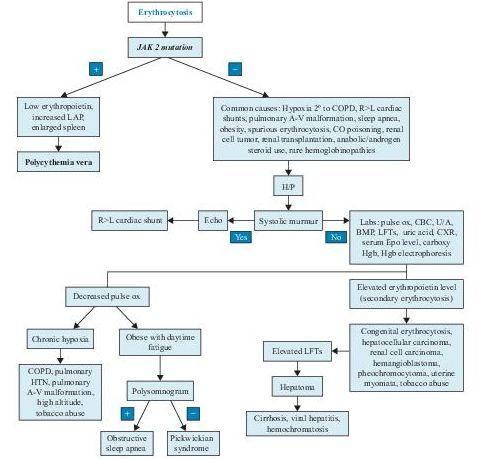Wallach's Interpretation of Diagnostic Tests: Pathways to Arriving at a Clinical Diagnosis (317 page)
Authors: Mary A. Williamson Mt(ascp) Phd,L. Michael Snyder Md

Certain tumors (hypernephroma, hepatoma, cerebellar hemangioblastoma, adrenal tumors, pheochromocytoma, uterine fibromyoma)
Androgen therapy, testosterone or erythropoietin abuse
Familiar erythrocytosis

Figure 9–2
Erythrocytosis algorithm.

WHITE BLOOD CELL DISORDERS
LEUKOCYTOSIS AND LEUKOPENIAS
Leukocytosis refers to a total white cell count >10,300/μL (in our laboratory). Counts up to 11,000 may be considered physiologic by allowing two standard deviations above the upper limit. Leukocytosis may reflect an absolute increase of neutrophils, lymphocytes, eosinophils, monocytes, basophils, or combinations. Leukopenia is defined as a total white cell count <4,300/μL.
Causes of Neutrophilia (Neutrophilic Leukocytosis)
In adults, neutrophilia is defined as an increase in the absolute neutrophil count >7,500/μL (or >72%). A
relative
neutrophilia is seen when the other cellular elements (mostly the lymphocytes) are decreased. The
absolute
neutrophil count, as reported by automated counters, is a more reliable parameter than the percent count. Spurious neutrophilia may be reported by automated counters in the presence of clumped platelets or cryoglobulins. The counters will flag such results as not acceptable. Causes of neutrophilia can be divided into primary (clonal) and secondary.
Primary Neutrophilia
Myeloproliferative neoplasms
Neutrophilic leukemia (see p. 405)
Hereditary, giant neutrophilia (occasional large neutrophils with multiple nuclear lobes)
Hereditary neutrophilia, a rare autosomal dominant condition without medical problems
Chronic idiopathic neutrophilia, condition not associated with medical problems
Secondary Neutrophilia
Acute infections